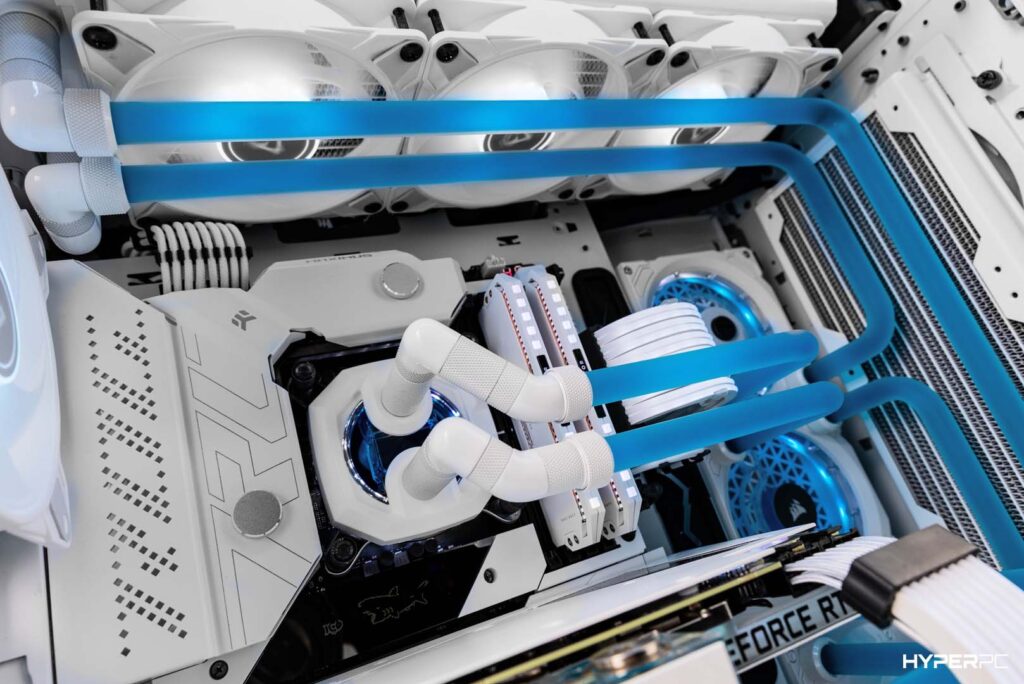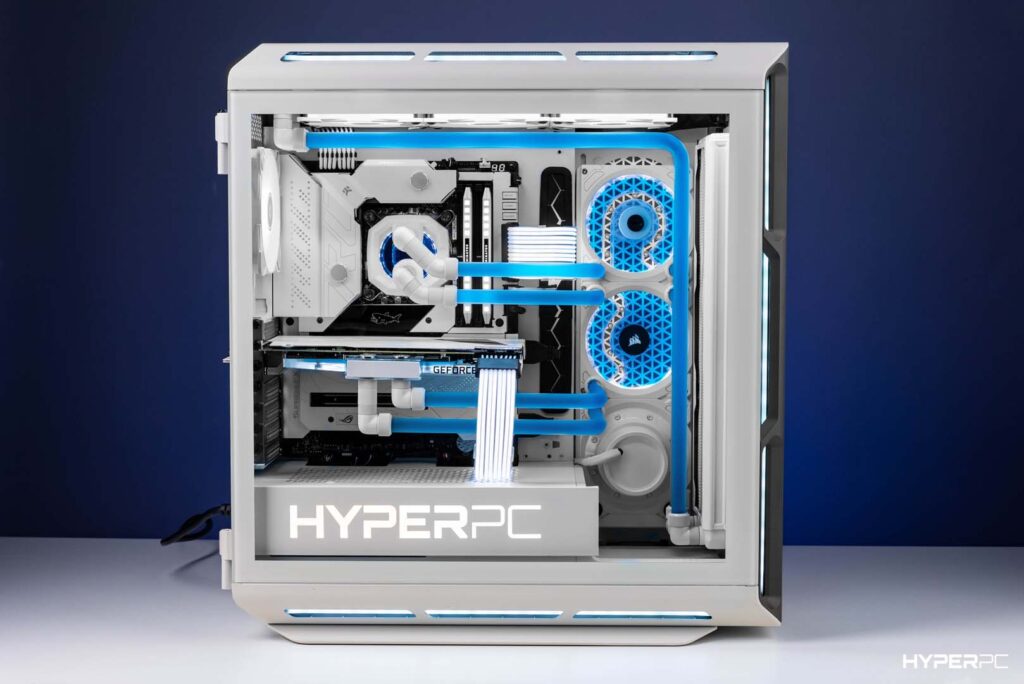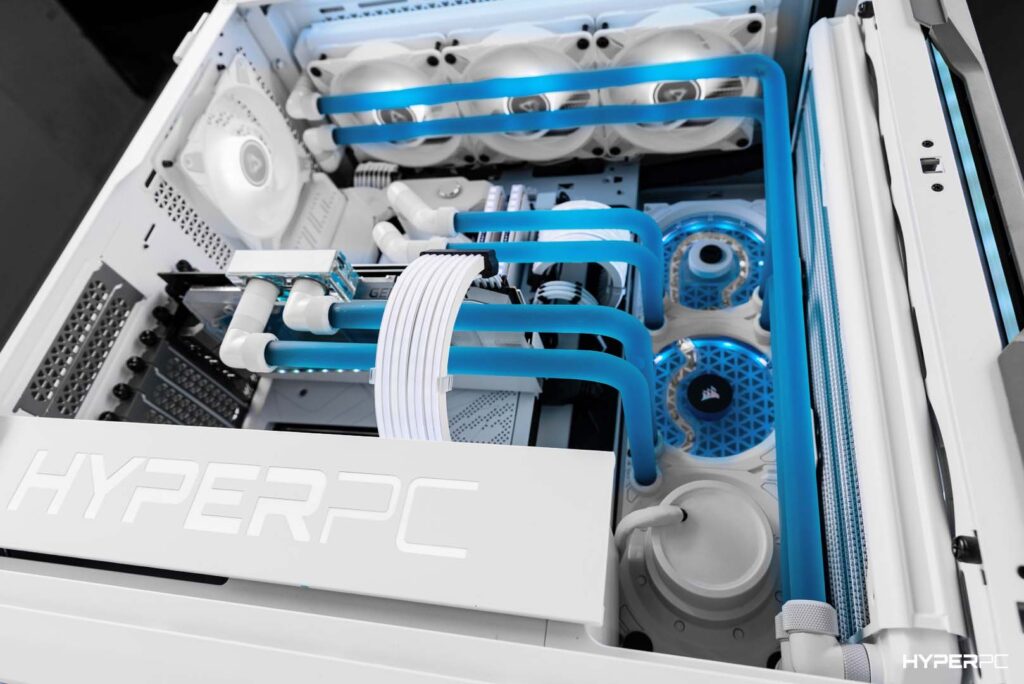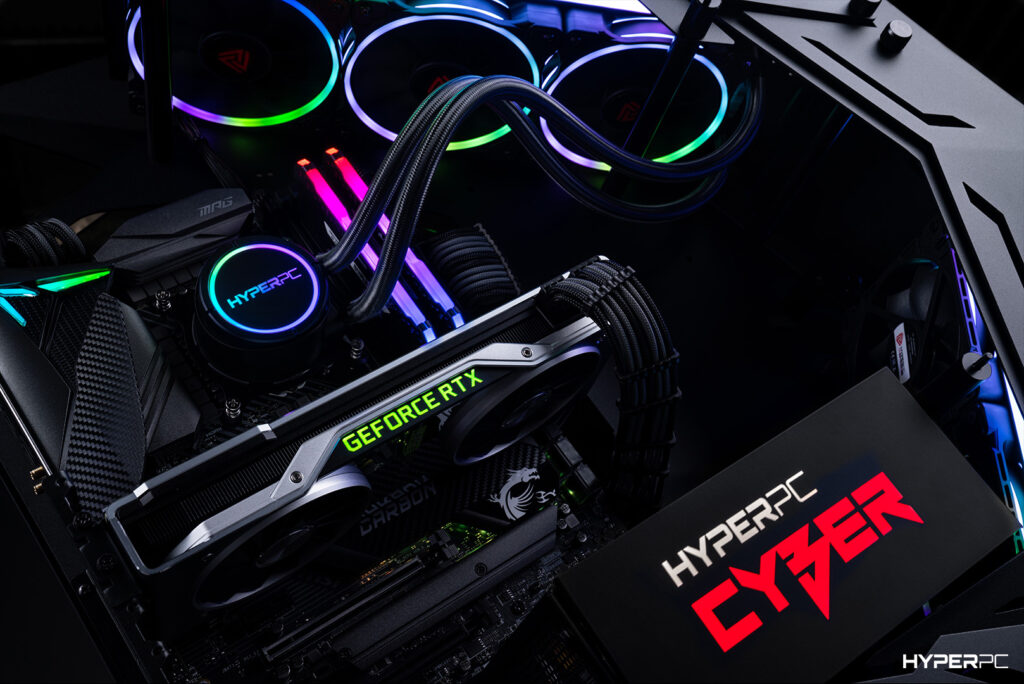During operation, the processor generates a lot of heat. It needs to be efficiently dissipated to prevent computer components from overheating and failing. A proper cooling system is especially important for gaming computers engaged in intensive calculations.
This task is solved in different ways, up to exotic and extreme ones, such as oil cooling or liquid nitrogen-based systems. Water cooling for PCs is a solution that is attracting more and more attention from gamers.
General Structure of Water Cooling System

The principle of water cooling is based on the thermodynamic properties of water: it requires much more energy to heat up than air.
The computer cooling is organized much like a similar system in a car: the liquid is circulated through the heat exchanger channels by pressure generated by the pump, enters the radiator, which is cooled by the airflow from the fan, and then returns to the heat exchanger.
Distilled water is used as the coolant, to which chemical substances reducing its corrosive properties are added. Sometimes dyes are also added to the water.
Parts of Water Cooling System

The main element that dissipates heat from the processor is the water block. It is a sealed metal reservoir with a flat contact area. The surface of this element is thoroughly polished for good contact with the heat exchanger and the processor.
The water block is installed on the processor with brackets that exclude any movement of the element. Although we are only talking about the processor here, the water block is often installed on the video card, and sometimes on the chipset of the motherboard, strips of RAM, and even the power supply.
The microchannel system in the base of the water block, which contacts the element that requires cooling, circulates water.
The hot liquid enters the radiator, which is similar in structure and principle to its automotive counterpart: heat-conducting tubes, usually copper, penetrate metal plates and transfer heat to them. It is then dissipated into the air.
To increase the efficiency of heat dissipation, one or more fans are used. It provides airflow to the radiator, ensuring its quick cooling. The radiator and fan(s) are assembled into a single block.
The heart of the water cooling system is the pump, which circulates the liquid in a loop. Its “vessels” are flexible hoses or rigid pipes, most often transparent, so that the movement of the liquid can be observed. The ends of the hoses and pipes are clamped with standard-sized fittings.
Expansion tank, which is needed to prevent water from damaging the system as it heats up and expands, can be either a separate structural element or built into the pump or radiator.
There are different ways to cool the processor, graphics card and other components of a computer. The two main types of liquid cooling are maintenance-free (closed-loop) and custom (open-loop) systems.
Types of Water Cooling Systems
A closed-loop system includes all the necessary elements and is supplied as a sealed unit. A custom system is assembled, like a computer, from various components, often from different manufacturers.
Both solutions have their pros and cons. A closed-loop system is proven and reliable, and with a custom system, all components can be more precisely selected for specific needs, and individual elements can be easily replaced if needed.
Building a custom system requires a higher level of expertise from the assembler, so if you want to build custom liquid-cooled PC, it’s best to turn to those with the necessary knowledge and experience.
Pros and Cons of Water Cooling

Liquid cooling systems have the following advantages:
- Efficiency. Usually, even a single-section liquid cooling system dissipates heat better than a similar air-cooled solution. However, when comparing liquid cooling systems with air-cooled systems that use heat pipes, the results are not so clear-cut.
- More compact placement. Cooling system components are less bulky than air-cooling components. They can be conveniently placed in the system unit so that nothing interferes with the movement of air inside the case and does not block access to the ports of the motherboard.
- Low noise level. Of course, in multi-section liquid cooling systems, both fans and pumps make noise, but the overall noise level is usually significantly lower than that of a computer with air cooling. In addition to “quiet” fans, the lower rotational speed of the fans also contributes to this.
- Possibility of fine-tuning and customization. This advantage applies only to custom systems that can be assembled to meet the needs of the computer owner.
Criticism of liquid cooling systems usually comes down to these arguments:
- High cost. Even single-section, non-serviceable systems have a cost comparable to a full-fledged cooler “tower”, and the upper limit for serviceable custom systems is unlikely to be reached.
- Risk of leaks. In tower coolers with heat pipes, water is also used as a coolant, but it is located inside a tightly closed reservoir. There are many connections in a water system, and no matter how reliable they may be, some risk of leaks still remains. The bad news is that the manufacturer only guarantees the cooling system components. If the computer components suffer from an accident, they will have to be replaced at their own expense.
- Short lifespan. Water is a chemically active substance, so even if only copper elements are used in the system, over time it will clog and fail. The use of dye pigments in the liquid, while beautiful, reduces the lifespan of water cooling even faster.
- Complexity of maintenance. This disadvantage applies mainly to serviceable systems: the first system startup must be done correctly, the liquid level, pump operation, and absence of sediment must be monitored.
As a rule, for gaming computers equipped with not too hot processors, air cooling on heat pipes is the optimal solution.
Using a liquid cooling system is usually a matter of personal aesthetic preference. It is really necessary either for systems with constant high loads on the top processor with a couple of dozen cores, or if extreme overclocking is used.
Leaders Among Water Cooling Systems
There are many variations of water cooling systems on the market. Let’s consider those that deserve special attention.
Single-section systems
In this category, the product of the DEEPCOOL company of the LS320 model is of interest. Its thermal power, that is, the amount of heat it can dissipate, ranges from 170 to 190 W.
This is a good option for a small mini-ITX form factor system unit. The water block is installed on both the Intel LGA 1700 socket and the AMD AM5 socket. Among the advantages, in addition to heat dissipation, are the quiet operation of the pump and fan even at maximum speeds. The rich set of the kit and the beautiful appearance complete the list of its advantages.
Two-section systems
Here we highlight two models: GamerStorm’s Castle 240EX and NZXT’s Kraken X63 RGB.
The first provides heat dissipation up to 250 W, has reliable leak protection, and has many wires, connectors, and various fixtures out of the box. This includes a pump speed controller.
The model is located in the “entry-level” price segment but shows excellent characteristics and is suitable for various socket types. The appearance is also not forgotten: the water block is equipped with a “hypnotic” backlight.
The second is an excellent solution for overclocking Ryzen line processors. Kraken fans have an extended resource, work quietly, and can be controlled both by hardware controllers and software. The main advantage is the ability to install the pump in a convenient location due to its rotation function.
Powerful systems

Two models that provide heat dissipation of 250 W or more also fall into the top category of water cooling.
The first is the Cooler Master MasterLiquid ML360P Silver Edition. This is one of the quietest representatives of its class. The hydrodynamic bearings of the fans are responsible for acoustic comfort. The water block base is made so that during installation, the thermal paste is concentrated in the hottest part of the processor, and excess is squeezed out beyond.
The pump is also installed in the monolithic heat sink block, so despite its size, the system is very compact. It is filled with fluid, and installation requires minimal effort. The fan controller can be installed outside if desired: it is attached to the case by a magnet.
The second is a solution from Arctic. The Liquid Freezer II 420 model has a water block that is equipped with an additional fan. It cools the liquid even before it enters the heat sink radiator and also cools the socket at the same time. The kit includes mounting for Intel and AMD sockets of the latest generations. Full-size cases are only suitable for installing a three-section radiator.
All images source: HYPERPC